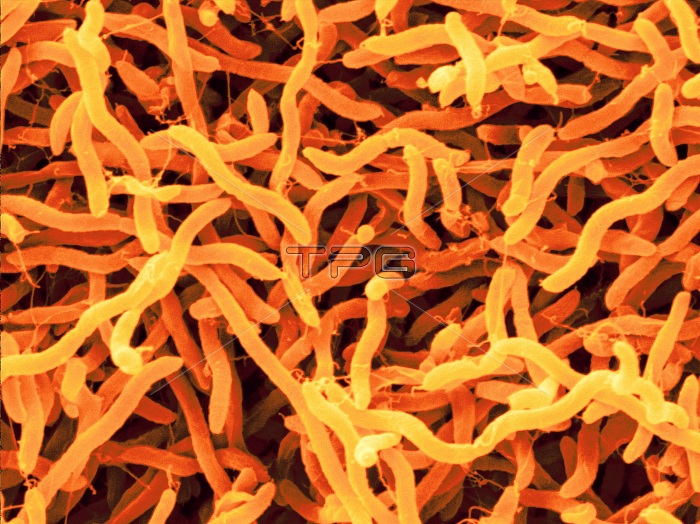
Color enhanced scanning electron microscope of arcobacter. This bacteria lives in soil, sludge, feces, stagnant water, sewage and other natural environments. Raw and undercooked meat (beef, pork, lamb), raw unpasteurized milk, untreated water, and shellfish have been implicated in the transmission of Arcobacter spp. They are now recognized as important human and animal pathogens which have been found to cause reproductive problems in pigs, abnormalities in rainbow trout, diarrhea in animals and humans, even rare but severe cases of bacteremia. Their optimal temperature is 25 to 30簞C so the relatively high body temperature of chickens (41簞C) protects them from having their intestines colonized with Arcobacter. Some time ago, Arcobacter were called "aerotolerant Campylobacter". Arcobacter is a member of the Epsilobacteria group, which also includes Campylobacter and Helicobacter spp. It is distinguished from Campylobacter by being able to grow in the presence of oxygen and at 15簞C. There are four species of Arcobacter currently recognized, of which two, Arcobacter butzleri and Arcobacter cryaerophilus, have been associated with human disease. A. butzleri may be the primary human pathogen. Arcobacter spp. are gram-negative, curved, s-shaped or helical non-spore-forming rods that are 0.2-0.9 micrometers wide and 1-3 micrometers long. They are motile with a single polar unsheathed flagellum. Most strains are non-haemolytic. Image width: 10.7 micrometers. Magnification: 9,345x if printed 10 cm wide.
| px | px | dpi | = | cm | x | cm | = | MB |
Details
Creative#:
TOP22230949
Source:
達志影像
Authorization Type:
RM
Release Information:
須由TPG 完整授權
Model Release:
N/A
Property Release:
No
Right to Privacy:
No
Same folder images:

 Loading
Loading